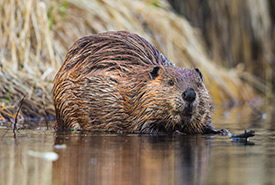Let’s keep the beavers in Beaver Hills

Beaver (Photo by Brent Calver)
Welcome to the Cooking Lake Moraine Natural Area, a land of mixedwood boreal forests, wetlands and many, many beavers! These beavers live among a mosaic of protected natural areas, agricultural lands and residential communities in the Beaver Hills Biosphere Reserve, a UNESCO internationally recognized biosphere.
The Beaver Hills got its name from the Cree people in the area. The Cree place name, Amiskwaciy, directly translates to Beaver Hills. Nomadic First Nations and Métis people traditionally used the Beaver Hills as a stopping place due to its many water sources and abundant plants and wildlife, such as beavers.
An emblematic Canadian animal, beavers are important landscape modifiers that provide many benefits to the ecosystems where they live. By building dams in streams and wetlands, beavers create the perfect habitat for their own lodges, while also supporting flood and drought resiliency, water quality and habitat for other species, such as moose and waterfowl. However, beavers’ influence on the landscape can also cause flooding upstream and drought downstream, which is not always ideal for farmers, landowners and nearby county infrastructure nearby.
This contrast between ecological benefits and human inconveniences led to the development of beaver coexistence projects on several Nature Conservancy of Canada (NCC) properties in the Cooking Lake Moraine Natural Area. While monitoring the Gambling Lake-Carey property in the Beaver Hills Biosphere, NCC staff noticed that a beaver had dammed Katchemut Creek, preventing water from flowing through the culvert underneath the nearby county road. Thankfully, there are many tools that allow people to coexist peacefully alongside beavers like this one.
NCC staff chose an exclusion fence and a pond leveler as tools for this site. First, with the help of Beaver County, the beaver dam at the culvert was quickly cleared. Next, wire fencing was installed around the culvert opening to prevent the beaver from getting in. Lastly, a large pipe, called a pond leveler, was installed to allow water to flow through the exclusion fence and into the culvert.
Even though the beaver quickly built a new dam on the outside of the fence, Katchemut Creek was still able to flow through the pond leveler.
These coexistence tools allow the beavers to continue building dams while preventing damage to surrounding lands and infrastructure. Studies have shown that coexistence tools are a very cost-effective way of dealing with beaver issues compared to traditional management techniques. Not to mention, they prevent problem beavers from being trapped or poisoned.
Maintaining a healthy beaver population in the Beaver Hills aligns with NCC’s property goals. Several NCC properties in the Cooking Lake Moraine Natural Area are part of an essential wildlife corridor, providing natural habitat for animals to travel through. There is also a very high density of wetland areas with important riparian habitat that is often shaped by beaver activity.
NCC’s natural areas would not be the same without beavers, and although they can cause headaches, the ongoing maintenance and monitoring of beaver coexistence projects will remain a priority to keep the beavers in Beaver Hills.





